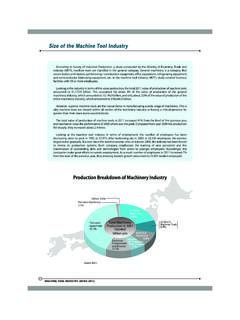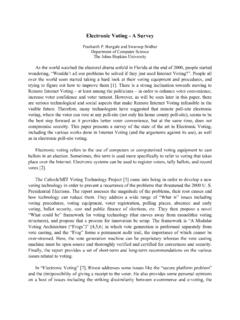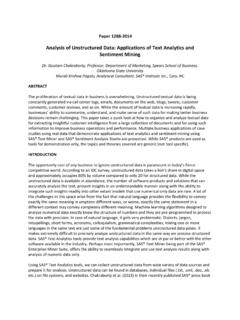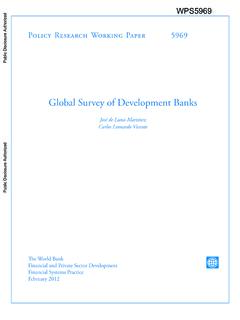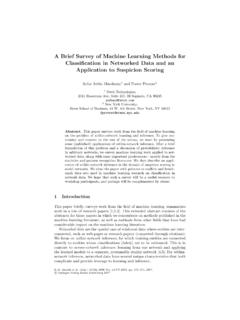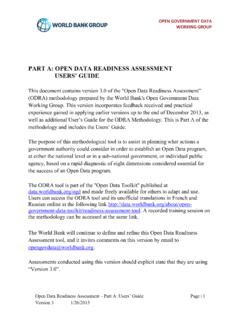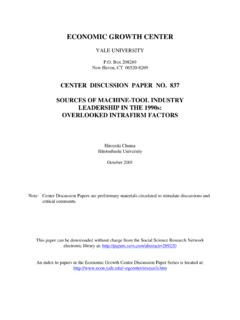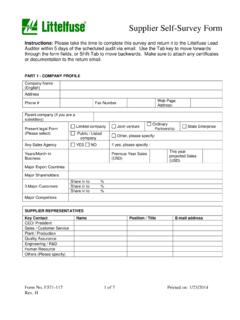Transcription of 2016 - Deloitte US
1 2016 global manufacturing competitiveness IndexTo start a new section, hold down the apple+shift keys and click to release this object and type the section title in the box this studyThe 2016 global manufacturing competitiveness index (GMCI) report is the third study prepared by the Deloitte Touche Tohmatsu Limited (DTTL) global Consumer & Industrial Products Industry Group and the Council on competitiveness , with prior studies published in 2010 and 2013. This multi-year research platform is designed to help global industry executives and policy makers evaluate drivers that are key to company and country level competitiveness as well as identify which nations are expected to offer the most competitive manufacturing environments through the end of this decade.
2 The 2016 study includes more than 500 survey responses from senior manufacturing executives around the world. For more information concerning the specifics of this study and its participants, please consult the start a new section, hold down the apple+shift keys and click to release this object and type the section title in the box from the 2016 global manufacturing competitiveness index 1 The impact of an evolving manufacturing landscape 3 global manufacturing competitiveness index : Country rankings 4It is Back to the future at the top of the manufacturing rankings 5 Regional clusters of strength emerge 9 BRIC breaks down 13 The rise of the MITI-V (the Mighty 5 ).
3 Searching for the next China 15 Examining the drivers of global manufacturing competitiveness 17 Spotlight: Impact of public policy on competitiveness 37 Conclusion 41 Appendix A: Supplemental country analysis of future top 10 GMCI nations 43 Appendix B: index methodology 63 Figures and tables endnotes 71 Text endnotes 83 Acknowledgements 87 ContentsTo start a new section, hold down the apple+shift keys and click to release this object and type the section title in the box from the 2016 global manufacturing competitiveness IndexChina and the United States (US) jockey for top honors while Germany holds firm China is the most competitive manufacturing now.
4 Consistent with the previous 2010 and 2013 global manufacturing competitiveness index studies, China is again ranked as the most competitive manufacturing nation in 2016, but is expected to slip to second position as global executives provide their perspective on how the next five years will play out (Figure 1, page 5). The United States is expected to take over the number one position from China by the end of the decade while Germany holds firm at number three: The United States continues to improve its ranking from 4th in 2010 to 3rd in 2013 to 2nd in this year s study. Moreover, executives expect the United States to assume the top position before the end of the decade while Germany holds strong and steady at the number three position now through the end of the decade (Figure 1, page 5).
5 Shifting dynamics among global manufacturing nations CEOs say advanced manufacturing technologies are key to unlocking future competitiveness : As the digital and physical worlds converge within manufacturing , executives indicate the path to manufacturing competitiveness is through advanced technologies, ranking predictive analytics, Internet-of-Things (IoT), both smart products and smart factories via Industry , as well as advanced materials as critical to future competitiveness (Table 2, page 7). Shift to higher value, advanced manufacturing tilts the advantage to developed nations in the future: As the manufacturing industry increasingly applies more advanced and sophisticated product and process technologies and materials, traditional manufacturing powerhouses of the 20th century ( the United States, Germany, Japan, and the United Kingdom) are back toward the very top of the 10 most competitive nations in 2016.
6 These nations which invested in advanced manufacturing technologies, are projected to remain in top 10 until the end of the decade. Innovation, talent, and ecosystems play a key role in their renewed strength (Figure 1, page 5). Regional clusters of strength emerge: Out of the top 10 manufacturing competitive nations, two regions, North America and Asia Pacific dominate the competitive landscape. All three North American countries are in the top 10 today and are expected to remain in the top 10 ranking five years from now. As many as five Asia Pacific nations (China, Japan, South Korea, Taiwan, and India) are expected to factor in the top 10 by 2020, leaving only two spots remaining for Germany and the United Kingdom to represent Europe in the top 10 (Figure 3, page 9).
7 BRIC breaks down: Of the BRIC countries (Brazil, Russia, India, and China), only China is viewed by executives as a top 10 manufacturing nation in 2016. The other three BRIC nations have experienced a significant decline in their rankings over the last few years. Among the three, Brazil has had the steepest fall, ranking 29th in 2016 compared to 8th and 5th in 2013 and 2010, respectively. Similarly, Russia slumped further down the list to 32nd in 2016 from 28th in 2013 and 20th in 2010. On the other hand, hope still remains for India s rank position to improve from 11th in 2016 to the number five spot by 2020.
8 The rise of the Mighty Five : The five Asia Pacific nations of Malaysia, India, Thailand, Indonesia, and Vietnam (MITI-V aka the Mighty Five ) are expected to pierce the top 15 nations on manufacturing competitiveness over the next five years. These nations could represent a New China in terms of low cost labor, agile manufacturing capabilities, favorable demographic profiles, market and economic growth, with their competitiveness ranking rising in the next five years as China continues to shift its focus towards a higher value, advanced technology manufacturing paradigm (Table 4, page 15).
9 Top drivers of manufacturing competitiveness Talent remains number one: Consistent with the 2010 and 2013 global manufacturing competitiveness index studies, manufacturers continue to rank talent as the most critical driver of global manufacturing competitiveness (Figure 6, page 17). Cost competitiveness (number two), productivity (number three), and supplier network (number four) are also key: In an era of sluggish economic growth, containing costs and increasing productivity to boost profits remains critical for manufacturers, alongside building a strong network and ecosystem of suppliers (Figure 6, page 17).
10 Impact of public policy A more favorable policy environment for manufacturing : Executives throughout the United States, Europe, and China indicated their respective nations have a number of more favorable policies around key elements of manufacturing competitiveness than even three years ago. Specifically around the areas of technology transfer, as well as science and innovation, executives indicated their nations have favorable policies to encourage manufacturers to increasingly use advanced technologies to improve their manufacturing competitiveness . Intellectual property protection also rose towards the top of competitive advantages in the United States and Europe, while it was absent from the list of advantages in start a new section, hold down the apple+shift keys and click to release this object and type the section title in the box below.










